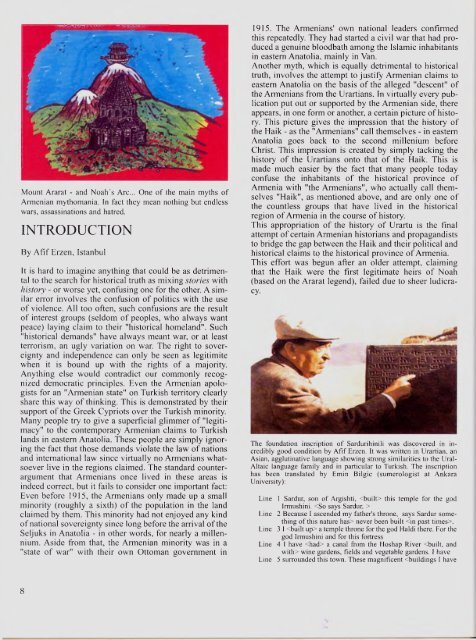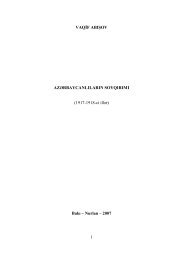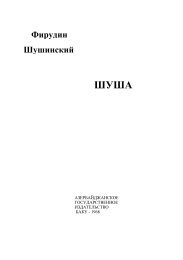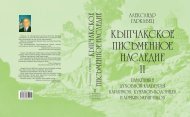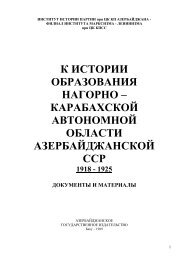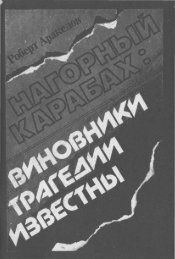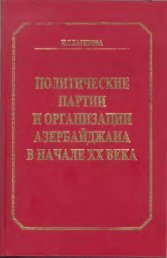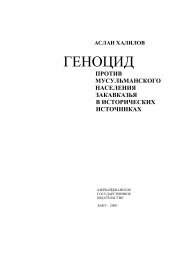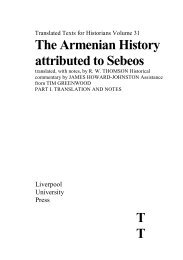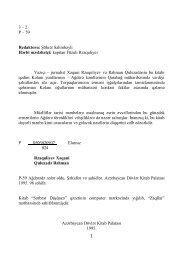ARMENIAN - Erevangala500
ARMENIAN - Erevangala500
ARMENIAN - Erevangala500
You also want an ePaper? Increase the reach of your titles
YUMPU automatically turns print PDFs into web optimized ePapers that Google loves.
И — — — М М М<br />
Mount Ararat - and Noah's Arc... One o f the main myths of<br />
Armenian mythomania. In fact they mean nothing but endless<br />
wars, assassinations and hatred.<br />
INTRODUCTION<br />
By A fif Erzen, Istanbul<br />
It is hard to imagine anything that could be as detrimental<br />
to the search for historical truth as mixing stories with<br />
history - or worse yet, confusing one for the other. A similar<br />
error involves the confusion o f politics with the use<br />
of violence. All too often, such confusions are the result<br />
of interest groups (seldom of peoples, who always want<br />
peace) laying claim to their "historical homeland". Such<br />
"historical demands" have always meant war, or at least<br />
terrorism, an ugly variation on war. The right to sovereignty<br />
and independence can only be seen as legitimite<br />
when it is bound up with the rights of a majority.<br />
Anything else would contradict our commonly recognized<br />
democratic principles. Even the Armenian apologists<br />
for an "Armenian state" on Turkish territory clearly<br />
share this way o f thinking. This is demonstrated by their<br />
support of the Greek Cypriots over the Turkish minority.<br />
Many people try to give a superficial glimmer of "legitimacy"<br />
to the contemporary Armenian claims to Turkish<br />
lands in eastern Anatolia. These people are simply ignoring<br />
the fact that those demands violate the law of nations<br />
and international law since virtually no Armenians whatsoever<br />
live in the regions claimed. The standard counterargument<br />
that Armenians once lived in these areas is<br />
indeed correct, but it fails to consider one important fact:<br />
Even before 1915, the Armenians only made up a small<br />
minority (roughly a sixth) of the population in the land<br />
claimed by them. This minority had not enjoyed any kind<br />
of national sovereignty since long before the arrival of the<br />
Seljuks in Anatolia - in other words, for nearly a millennium.<br />
Aside from that, the Armenian minority was in a<br />
"state o f war" with their own Ottoman government in<br />
8<br />
1915. The Armenians' own national leaders confirmed<br />
this repeatedly. They had started a civil war that had produced<br />
a genuine bloodbath among the Islamic inhabitants<br />
in eastern Anatolia, mainly in Van.<br />
Another myth, which is equally detrimental to historical<br />
truth, involves the attempt to justify Armenian claims to<br />
eastern Anatolia on the basis of the alleged "descent" of<br />
the Armenians from the Urartians. In virtually every publication<br />
put out or supported by the Armenian side, there<br />
appears, in one form or another, a certain picture of history.<br />
This picture gives the impression that the history of<br />
the Haik - as the "Armenians" call themselves - in eastern<br />
Anatolia goes back to the second millenium before<br />
Christ. This impression is created by simply tacking the<br />
history of the Urartians onto that of the Haik. This is<br />
made much easier by the fact that many people today<br />
confuse the inhabitants of the historical province of<br />
Armenia with "the Armenians", who actually call themselves<br />
"Haik", as mentioned above, and are only one of<br />
the countless groups that have lived in the historical<br />
region of Armenia in the course o f history.<br />
This appropriation of the history o f Urartu is the final<br />
attempt of certain Armenian historians and propagandists<br />
to bridge the gap between the Haik and their political and<br />
historical claims to the historical province of Armenia.<br />
This effort was begun after an older attempt, claiming<br />
that the Haik were the first legitimate heirs o f Noah<br />
(based on the Ararat legend), failed due to sheer ludicra-<br />
cy.<br />
The foundation inscription of Sardurihinili was discovered in incredibly<br />
good condition by Afif Erzen. It was written in Urartian, an<br />
Asian, agglutinative language showing strong similarities to the Ural-<br />
Altaic language family and in particular to Turkish. The inscription<br />
has been translated by Emin Bilgic (sumerologist at Ankara<br />
University):<br />
Line 1 Sardur, son of Argishti, this temple for the god<br />
Irmushini. <br />
Line 2 Because I ascended my father's throne, says Sardur something<br />
of this nature has> never been built .<br />
Line 3 I a temple throne for the god Haldi there. For the<br />
god Irmushini and for this fortress<br />
Line 4 1 have a canal from the Hoshap River wine gardens, fields and vegetable gardens. I have<br />
Line 5 surrounded this town. These magnificent


